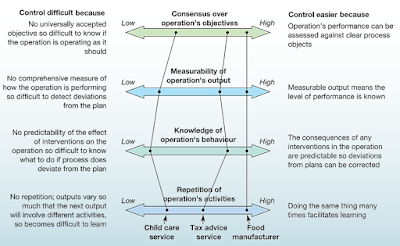Planning & control activities
Planning & control requires the reconciliation of supply
& demand in terms of volumes, timing & quality
Loading
Finite loading
Approach which only allocates work to a work center (person,
machine etc.) up to a set limit.
Particularly relevant for operations where
- It is possible to limit the load
- It is necessary to limit the load
- The cost of limiting the load is not prohibitive
Infinite loading
Approach to loading work which does not limit accepting
work, but instead tries to cope with it.
Particularly relevant for operations
where
- It is not possible to limit the load
- It is not necessary to limit the load
- The cost of limiting the load is prohibitive
Sequencing
Decisions must be taken on the order in which the work will
be tackled.
The priorities are often determined by some predefined set
of rules, some are
- Physical constraints
- Priority of work is determined by physical nature of the materials
- Customer priority
- Due date (DD)
- Work is sequenced according to when it is ‘due’ for delivery, irrespective of the size of each job or the importance of each customer
- Last-in first-out (LIFO) (Unloading an elevator)
- First-in first-out (FIFO) sometimes called ‘first come, first served’ (FCFS)
- Longest operation time (LOT)
- Sequence the longest jobs first in the system
- Shortest operation time first (SOT)
- Sequence the shortest jobs first in the system
Johnson’s Rule of Sequencing
Technique for minimizing makespan for a group of jobs
to be processed on two machines or at two work centers. (Makespan
is the total time needed to complete a group of jobs)
- - Minimizes total idle time
Conditions must be satisfied
- Job time must be known & constant for each job
- Job times must be independent of the job sequence
- All jobs must follow the same two-step work sequence
- A job must be completed at the first work center before the job moves on to the second work center
Steps
- Select the job with the shortest time. If the shortest time is at the first work center, schedule that job first; if the time is at the second work center, schedule the job last. Break ties arbitrarily
- Eliminate the job & its time from further
- Repeat steps 1 & 2, toward center & complete all jobs
Judging sequencing rules
The following performance objectives are often used judge
the effectiveness of sequencing rules
- Meeting ‘due date’ promised to customer (dependability)
- Minimizing the time the job spends in the process, also known as ‘flow time’ (speed)
- Minimizing work-in-progress inventory (an element of cost)
- Minimizing idle time of work centers (another element of cost)
Scheduling
Establishing the timing of the use of equipment, facilities,
& human activities in an organization
- Effective scheduling can yield cost savings, increases in productivity, & other benefits
- The most complex tasks in operations management
Forward scheduling
Forward scheduling involves starting work as soon as it
arrives
- Scheduling ahead from a point in time
Backward scheduling
Backward scheduling involves starting jobs at the last
possible moment to prevent them from being late
- Scheduling backward from a due date
The choice of backward or forward scheduling depends largely
upon the circumstance
Gantt charts
Chart used as visual aid for loading & scheduling
purposes
- A simple device which represents time as a bar, or channel, on a chart
- Purpose of Gantt charts is to organize & visually display the actual or intended use of resources in a time framework
A time scale is represented horizontally & resources are
represented vertically
Scheduling work patterns
The schedule of work times effectively determines the
capacity of the operation.
- Make sure that sufficient numbers of people are working at any point in time to provide a capacity appropriate for the level of demand at that point in time, is often called staff Rostering.
- Capacity matches demand
- The length of each shift is neither excessively long nor too short
- Working at unsocial hours is minimized
- Days off match agreed staff conditions (for example – staff prefer two consecutive days off every week)
- Vacation & other ‘time-off’ blocks are accommodated
- Sufficient flexibility is built into the schedule to cover for unexpected changes in supply & demand
Scheduling staff times is one of the most complex of
scheduling problems
Monitoring & controlling the operation
Having created a plan for the operation through loading,
sequencing & scheduling, each part has to be monitored to ensure that
planned activities are indeed happening
Push & pull control system
Drum, buffer, rope
The drum, buffer, rope concept comes from the theory of
constraints (TOC)
Drum: The bottleneck in the process should be the
control point of the whole process, because it sets the ‘beat’ for the rest of
the process to follow
Buffer: Potentially constraining resources outside of
the bottleneck, the role is to keep a small amount of inventory ahead of the
bottleneck operation to minimize the risk of having it be idle
Rope: The synchronizing of the sequence of operations
to ensure effective use of the bottleneck operations, goal is to avoid costly
& time-consuming multiple setups, particularly of capacity-constrained
resources, so they do not become bottlenecks too
Five-step procedure
- Determine what is constraining the operation
- Exploit the constraint (constraint resource is used to its maximum)
- Subordinate everything to the constraint (focus on the constraint)
- Determine how to overcome (eliminate) the constraint
- Repeat the process for the next highest constraint












No comments:
Post a Comment